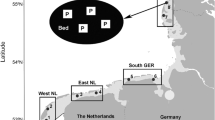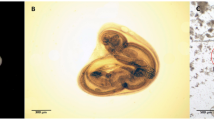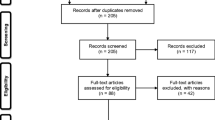Abstract
It is widely assumed that the likelihood of invasion decreases with increased species richness in the recipient community. However, the invasion paradox supports a negative and a positive relationship between native biodiversity and the success of an invader. Here, we show that for a host–parasite system (Anguilla anguilla as host and Anguillicoloides crassus as parasitic invader), invasion increases with native micro- and macroparasitic species richness. In fact, about 30% of the A. crassus intensity in eels could be explained by the number of both micro- and macroparasite species. This pattern could be due to the fact that A. crassus exploits a niche (the swim bladder) that is unoccupied by native parasite species and by the Th1/Th2 trade-off between native microparasites and the invader. We conclude that the host–parasite system resistance to invasion may depend on both niche availability and the Th1/Th2 trade-off. As well, we encourage researchers to incorporate native parasite richness as a risk factor in epidemiological models of A. crassus.

Similar content being viewed by others
References
Álvarez-Pellitero P (2008) Fish immunity and parasite infections: from innate immunity to immunoprophylactic prospects. Vet Immunol Immunopathol 126:171–198
Bordes F, Morand S (2009) Parasite diversity: an overlooked metric of parasite pressures? Oikos 118:801–806
Burnham KP, Anderson DR (2002) Model selection and multimodel inference: A practical information-theoretic approach. Springer, New York
Bush AO, Lafferty KD, Lotz JM, Shostak AW (1997) Parasitology meets ecology on its own terms: Margolis et al. revisited. J Parasitol 83:575–583
Case TJ (1990) Invasion resistance arises in strongly interacting species-rich model competition communities. Proc Natl Acad Sci USA 87:9610–9614
Dunstan PK, Johnson CR (2004) Invasion rates increase with species richness in a marine epibenthic community by two mechanisms. Oecologia 138:285–292
Fazio G, Sasal P, Lecomte-Finiger R, Da Silva C, Fumet B, Moné H (2008) Macroparasite communities in European eels, Anguilla anguilla, from French Mediterranean lagoons, with special reference to the invasive species Anguillicola crassus and Pseudodactylogyrus spp. Knowl Managt Aquatic Ecosyst 1:390–391
Fazio G, Mone H, Da Silva C, Simon-Levert G, Allienne JF, Lecomte-Finiger R, Sasal P (2009) Changes in gene expression in European eels (Anguilla anguilla) induced by infection with swim bladder nematodes (Anguillicola crassus). J Parasitol 95:808–816
Fenton A, Lamb T, Graham AL (2008) Optimality analysis of Th1/Th2 immune responses during microparasite-macroparasite co-infection, with epidemiological feedbacks. Parasitology 135:841–853
Freyholf J, Kottelat M (2008) Anguilla anguilla .IUCN Red List of Threatened Species, version 2010. www.iucnredlist.org, accesed 28/10/2010
Fridley JD, Stachowicz JJ, Naeem S, Sax DF, Seabloom EW, Smith MD, Stohlgren TJ, Tilman D, von Holle B (2007) The invasion paradox: reconciling pattern and process in species invasions. Ecology 88:3–17
Graham AL (2008) Ecological rules governing helminth-microparasite coinfection. Proc Natl Acad Sci USA 105:566–570
Joerink M, Forlenza M, Ribeiro CMS, de Vries BJ, Savelkoul HFJ, Wiegertjes GF (2006) Differential macrophage polarisation during parasitic infections in common carp (Cyprinus carpio L.). Fish Shellfish Immunol 21:561–571
Kennedy CR, Guégan J-F (1996) The number of niches in intestinal helminth communities of Anguilla anguilla: are there enough spaces for parasites? Parasitology 113:293–302
Moravec F, Taraschewski H (1988) Revision of the genus Anguillicola Yamaguti 1935 (Nematoda: Anguillicolidae) of the swimbladder of eels, including descriptors of two new species, A. novaezelandiae sp. N., and A. papernai sp. N. Folia Parasitol 35:125–146
Pedersen AB, Fenton A (2007) Emphasizing the ecology in parasite community ecology. Trends Ecol Evol 22:133–139
Pérez JM, Meneguz PG, Dematteis A, Rossi L, Serrano E (2006) Parasites and conservation biology: the “Ibex-ecosystem”. Biodivers Conserv 15:2033–2047
Poulin R (2007) Are there general laws in parasite ecology? Parasitology 134:763–776
R Development Core Team 2.10.1 (2009) A language and environment for statistical computing. R Foundation for Statistical Computing, Vienna, Austria http://www.R-project.org, accessed 28/10/2010
Rahhou I, Morand S, Lecomte-Finiger R, Sasal P (2005) Biogeographical relationships of the eel parasite Anguillicola crassus revealed by random amplified polymorphic DNA markers (RAPDS). Bull Fr Pêche Piscic 378–379:87–98
Rolbiecki L (2008) New data on the biology of the introduced exotic nematode Anguillicola crassus Kuwahara, Niimi et Itagaki, 1974 in the eel Anguilla anguilla in Lake Wdzydze (Polish waters). Int J Oceanogr Hidrobiol 37:37–48
Rosenzweig ML (2001) The four questions: what does the introduction of exotic species do to diversity? Evol Ecol Res 3:361–367
Schmidt GD (1986) Handbook of tapeworm identification. CRC Press, Boca Raton
Shea K, Chesson P (2002) Community ecology theory as a framework for biological invasions. Trends Ecol Evol 17:170–176
Stachowicz JJ, Byrnes JE (2006) Species diversity, invasion success, and ecosystem functioning: disentangling the influence of resource competition, facilitation, and extrinsic factors. Mar Ecol Prog Ser 311:251–262
Taraschewski H (2006) Hosts and parasites as aliens. J Helminthol 80:99–128
Würtz J, Taraschewski H (2000) Histopatological changes in the swimbladder wall of the European eel Anguilla anguilla due to infections with Anguillicola crassus. Dis Aquat Org 39:121–134
Acknowledgements
This work was supported by Fundación Séneca, Coordination Centre for Research (grant 04538/GERM/06). The authors wish to thank E. Romero for his assistance with the eel sampling and D. Riquelme for his technical assistance with parasite processing. E. Serrano is supported by the Juan de la Cierva postdoctoral programme of the MICINN, Spain.
Author information
Authors and Affiliations
Corresponding author
Additional information
Carlos Martínez-Carrasco and Emmanuel Serrano contributed equally to this work.
Rights and permissions
About this article
Cite this article
Martínez-Carrasco, C., Serrano, E., de Ybáñez, R.R. et al. The European eel—the swim bladder–nematode system provides a new view of the invasion paradox. Parasitol Res 108, 1501–1506 (2011). https://doi.org/10.1007/s00436-010-2200-8
Received:
Accepted:
Published:
Issue Date:
DOI: https://doi.org/10.1007/s00436-010-2200-8




